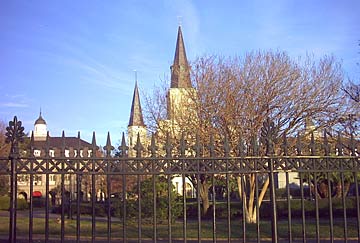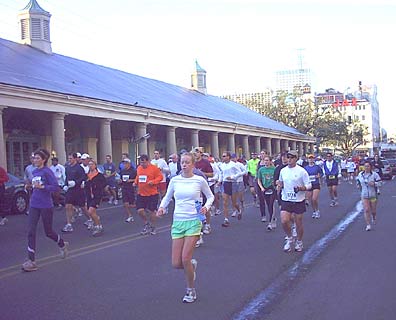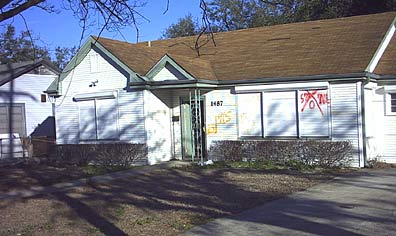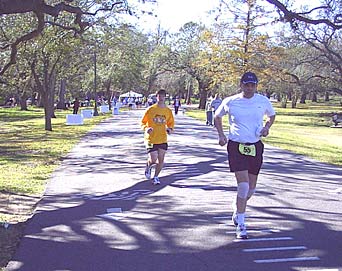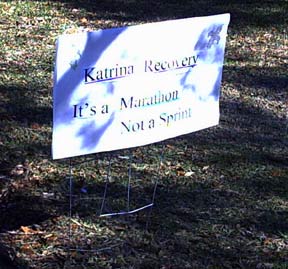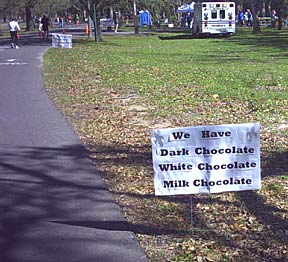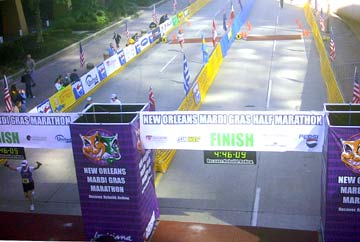|
Archive Files of Cajun, Creole, and Zydeco Musicians |
Mardi Gras
Marathon:
|
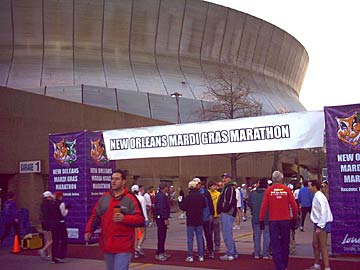 The Superdome will be ready for the opening home game of the Saints' 2006 football schedule, but at the time of the 2006 Mardi Gras Marathon it was still being repaired, so the marathon was headquartered adjacent to the dome instead of the traditional location inside.
David Simpson, the straggler who did this write-up, poses with a pigeon behind him in a photo taken after the marathon with a cheap digital camera using the self-timer. |
A Different Kind of Courir I discovered on February 5, 2006, that, when they have a Mardi Gras run in New Orleans, it's a bit different from the Mardi Gras runs around Eunice: no chicken chasing, no begging, and no drinking during the run except for Gatorade. Actually, when I found out in mid-December that New Orleans would accept the immense challenge in the aftermath of Hurricane Katrina of holding the 41st annual Mardi Gras Marathon this year, I decided I would take part, even though I knew I would be rather ill-prepared for the third marathon I had ever attempted in my life. A lot of other people from all over had the same response. Runners from all 50 states and from 18 other countries entered the race, a remarkable showing of solidarity with the City of New Orleans. The Mardi Gras marathon is not really one of the top-ranked races in the nation, so the great diversity of participants from near and far was truly a testament to the love that so many people have for the city. The success of the 2006 marathon under difficult circumstances should enhance the event's national status in the future. Another running opportunity in New Orleans is the 10K Crescent City Classic, held each April (April 15, 2006). Scenes Along the Route The race route started at the Superdome, headed down Decatur Street through the French Quarter, turned onto Esplanade Avenue and then went along the City Park into the Gentilly area, past homes that in September were inundated when the 17th Street Canal flood wall collapsed. The route then headed back past the Superdome and uptown on Prytania Street to Audubon Park before returning to the dome for the finish. Quick glimpses of the passing scenery as we went along offer a partial picture of what New Orleans is like today. Even with dumpsters filled with debris and gutted houses, the city remains beautiful. The French Quarter once more is attracting tourists, some of whom were out early for coffee at Café du Monde as we jogged past on Decatur. The trip through a section of Gentilly, however, was heartbreaking. The shells of the homes were intact, and a number of residents were camped in trailers beside their houses, trying to rebuild. A few residents were out to cheer us on. However, the majority of the homes on the street we ran down appear to have been vacated by owners who may never return. In the Garden District and Uptown neighborhoods, which did not flood, people were standing on the curbs or shouting encouragement from balconies, and, in Aububon Park, we ran along paths beside New Orleanians who had decided to take a stroll in the park on a beautiful Sunday morning. All along the route, New Orleans City Police stopped traffic at intersections, assistance that runners gratefully acknowledged as we went past. Hundreds of volunteers handed out cups of Gatorade and water, along with various snacks. When I finally arrived back at the dome with the other stragglers, I chowed down on four small bowls of red beans and rice. I was walking away from the dome toward my hotel when I heard in the distance behind me the unmistakable sound of "La chanson de Mardi Gras" coming from the speakers that played recorded music while an announcer called out the names of runners as they crossed the finish line. For more than five minutes, runners ended their New Orleans Mardi Gras Marathon to the tune of rural Acadiana's Mardi Gras song, performed in an extended version by Michael Doucet and BeauSoleil. New Orleans Open for Tourism My visit to New Orleans in early February 2006 confirms what I have been hearing: New Orleans is open for tourists. While the chain motels outside the central business district still were taken over by evacuees and recovery workers, the downtown hotels welcomed visitors. Many restaurants have reopened. Clubs that book Cajun and Zydeco bands like the Rock 'n' Bowl and Tipitina's (with its Sunday fais do-do featuring Bruce Daigrepont) have been open for a couple of months. Bourbon Street has, of course, long since returned to its usual activities. Streetcars are running once again. A number of stores along Canal Street remain boarded up while renovations are under way, but, early Saturday evening, downtown was bustling with people. Mardi Gras will be scaled back some in 2006, but the parade bleachers and stands were already in place in early February. The Jazz Fest will be held later this spring, so visitors will have plenty to see and hear. A Commentary New Orleans is a good place to visit, but for the city to return to anything like its former vibrancy, more native New Orleanians need an opportunity to go home. Their city was taken away from them by a hurricane that, if the levee and floodwall protection had worked as it was supposed to, should not have caused the worst catastrophe ever to hit a major American city. When I bought a Times-Picayune newspaper the evening before the marathon, I read a news report that confirmed the suspicions I have held ever since the day after the hurricane. The winds that hit the city were no stronger than a Category 2 storm and the flood protection was supposed to protect against a Category 3, so something had gone seriously wrong. According to the Feb. 4 story, an error in transferring soil boring data to a cross-sectional drawing used to design the 17th Street Canal flood wall led engineers to believe that firm clay soil existed below 16 or so feet down when in fact in the area where the flood wall failed the soil was composed of unstable, porous organic material down to 30 feet. The engineering assumptions were based on faulty information, so the wall did not hold as the engineers thought it would. The information may have been prepared by a consultant, but the Army Corps of Engineers hired the firm and, based on the preliminary findings described in the Times-Picayune article and on other reports, the Corps of Engineers should bear ultimate responsibility for the wall's collapse that flooded Lakeview, Gentilly, and other sections of New Orleans. Given the federal role in the failure to provide protection at the expected level, it is dismaying to many of us in Louisiana that President Bush is now opposing legislation by Republican Congressman Richard Baker from Baton Rouge (and endorsed by the rest of the Louisiana delegation, Democrat and Republican) to form the Louisiana Recovery Corporation that would use $30 billion in treasury bonds to purchase hurricane damaged homes on parcels that would be repackaged and redeveloped. Money from the sale of the properties would go back to the federal government. If this proposal is not a good idea, then New Orleans, as well as areas of Southwest Louisiana that were leveled by Hurricane Rita, needs some other effective means to promote rebuilding of homes. If the housing stock remains in ruins, people cannot return to the area, business recovery will be very weak, and New Orleans and other hard-hit sections of Louisiana will be struggling for decades to come. --David Simpson All photos on this page were taken with an inexpensive digital camera. Though the photo quality is low, the camera kept working even after it was dropped on the Decatur Street pavement. Posted 2-5-06 When I took part in the marathon in early February 2006, we had to start outside the Superdome because the usual starting point inside was still undergoing major repairs after Hurricane Katrina. As millions of people who watched the New Orleans Saints' victory on Sept. 25, 2006, know, the Superdome is now back better than ever, the Saints are playing superbly, and New Orleans is up and running, welcoming visitors. Yes, some sections of the city are still in ruins, but the parts that visitors want to see and enjoy are open. New Orleans is a beautiful, unique, fascinating city. Louisiana is a state that can offer you experiences you will find nowhere else. Come see for yourself. Major credit for the return of the New Orleans Saints to the Superdome belongs to Paul Tagliabue, the outgoing NFL commissioner, who, it should be noted, also made a generous contribution to support the 2006 Dewey Balfa Cajun and Creole Heritage Week. --D.S., posted 9-26-06
|

